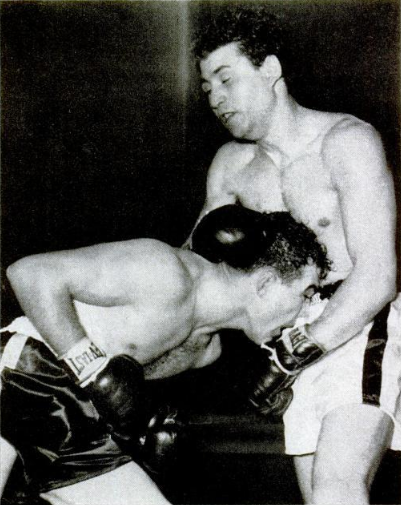Georgie Small vs Lavern Roach (lost footage of boxing match; 1950)
Small lands a blow on the back of Roach's head, a few minutes prior to the two knockdowns.
Status: Lost
On 22nd February 1950, middleweight boxers Georgie Small and Raymond "Lavern" Roach competed at the St. Nicholas Arena in Manhattan. The encounter ended in tragedy, as following a loss by KO in the tenth round, Roach collapsed, later passing away from a subdural haemorrhage. The match was televised live by CBS, and became the first televised boxing match to end with a boxer's death.
Background
Heading into the match, Roach was making a comeback into the ring.[1][2][3][4][5][6] Previously, he had served in the U.S. Marines, where his talent for boxing was already noted, leading him to become the team captain of its Cherry Point boxing team.[7][8][3][2] Additionally, he was deemed the greatest boxer produced in the Marines during the Second World War, receiving an accolade from boxer Gene Turney.[8][7] Following his time in the Marines, he turned to professional boxing in 1945, building up a 18-fight winning streak and even being declared the "Rookie of the Year" in 1947 by Ring Magazine.[1][7][2][3][6][5] However, an unsuccessful encounter against Marcel Cerdan on 16th January 1948 ended his winning streak, and was described as a brutal affair as the Frenchman battered the American with decisive blows.[2][4][1][3][5][6] A further two losses caused him to quit boxing for about 18 months to start a tyre repair and insurance business in his hometown of Plainview.[3][1][2][6]
He nevertheless returned in 1950, defeating Johnny Crosby, George LaRover, and Jimmy Taylor.[6][3][5][2][4] According to TIME, Roach insisted that the damage that Cerdan inflicted onto him was gone, and he was still in tip-top form.[1] His next match would be against Georgie Small on 22nd February 1950, the date of the Texan's 24th birthday.[6][3][2] Small had built a 38-6 fight record, his final match heading into the bout being a TKO victory against Vinnie Cidone on 11th November 1949.[9][2] By comparison, Roach was at 26-4.[2][6]
The Fight
The Roach-Small clash was scheduled for ten rounds.[2][1][3][4] Roach was deemed the 5-6 favourite heading in, with great expectations for his future should he become victorious.[10][3] According to West Texas Middleweight: The Story of Lavern Roach, a win would see Roach a favourite to take on one of the top middleweight stars of the era, including Rocky Graziano, Sugar Ray Robinson, and Jake La Motta, as well as working towards a potential title shot.[10][2] The encounter took place in front of only 1,832 in-attendance at the St. Nicholas Arena, as it occurred during winter weather.[5][10][2] Nevertheless, it did receive live coverage from the CBS Network, which attracted a few million viewers.[5][2][10]
Overall, various reports, including from The New York Times, indicate that Roach dominated the majority of rounds.[3][1][4][10][2] Had the match ended after all ten rounds had elapsed, it is likely Roach would have been declared the victor.[3][1][5][10][2] The New York Times noted referee Frank Fullam put Roach ahead in rounds with a score of 6-2-1, whereas judges Sam Rosenblatt and Dave Stewart both stated Roach was winning 6-3.[3][5] However, in the eighth round, a right hand blow from Small landed on Roach's jaw.[11][1][2][4] While Roach continued, he was not only staggered, but was heavily bleeding from his lips and mouth.[1][2][11] Despite this, he continued into the ninth round, with Small having to deal with a more-defensive opponent and blood seeping onto his gloves.[1][2][4] At the start of the final round, it appeared business as usual was occurring, forcing Small to launch a comeback to stand any chance of winning.[3][4][2][1][11] Suddenly, a right hook to the chin took Roach down to the mat and splattered blood onto his trunks.[3][4][11][10] While in a fatigued and compromised state, Roach made it to his feet at the count of nine.[1][3][4] The extent of Roach's injuries led to the Manhattan crowd demanding the match be stopped.[1][2] Roach was defeated when Small achieved another knockdown shortly after the first, this time convincing Fullam to end the match immediately out of concern for Roach's health at 1:57 into the tenth round.[3][1][2][4][11][10][6][9]
According to West Texas Middleweight: The Story of Lavern Roach, the match ended ten minutes earlier than expected.[10] Thus, CBS continued rolling footage showcasing the post-match events.[10][1][2] Roach at the time was helped back to his corner by two men, where he insisted to his handlers that he was OK and answering Fullam's questions.[1][10][2] Suddenly, the young boxer fell unconscious with an account from Bad Left Hook's Ted Sares indicating that blood was flowing across the ring.[2][1][3] His final words were "My luck is running out".[12][1] Roach was worked on for several minutes by doctors until he was taken via stretcher to St. Clare's Hospital.[5][2][3] Ultimately, he passed away 14 hours later from a ruptured pial emissary vein on the left side of his head which triggered a subdural haemorrhage, aged 24.[4][1][2][5][3][11] An autopsy indicated that while alleged nose pains Roach experienced had no linking to his death, his brutal loss to Cerdan two years prior may have contributed to it.[4][11][5][2][1] It led to a full investigation from The New York State Athletic Commission, but with Small facing no charges.[4][3] It was found that Roach's death was accidental, with him being cleared in six previous examinations prior to the bout.[4] Additionally, Fullam insisted that Roach was not in a dangerous condition following the first knockdown, stating he was still intending and able to fight Small.[4] Small himself claimed he did not realise Roach was in a precarious state.[4] Nevertheless, the investigation's findings led to reforms, including introducing extensive medical screenings, more concern placed over health effects caused from previous fights, and a softer ring mat.[12]
Roach's death led to mourning in Plainview, as aside from his Marine and boxing accomplishments, he was considered a highly popular, sporting, and clean-living individual.[7] At Plainview High School since 1950, a senior male student will be given the Lavern Roach Memorial Award, the biggest honour to a male graduate at the School, with the aim of increasing sportsmanship, clean-living, and acts of friendliness.[7][8] His name would also be honoured on Plainview's Walk of Fame in 2017.[7] Meanwhile, Small continued boxing, but found himself shunned by most top boxers who refused to face him.[13][9] He continued until 1955, although accounts indicate Small never truly overcame the guilt over the match's outcome.[13][9] Ten years following the bout, as part of True Magazine's '63 Boxing Annual, Small expressed "I wanted to be a fighter. All my whole life I wanted to be a fighter... And see what happened. I'm broke and sick. I got my wife broke. I ruined everything. I guess the only thing I ever did in my whole life was kill a friend."[13] The first boxing fatality of 1950, the match is also cited as the first televised instance of a boxing match ending with one of the competitors passing away.[14][2][1]
Availability
The fight was televised live by CBS as part of its CBS Wednesday Night.[2][5] According to Bad Left Hook, Don Dunphy may have provided commentary for the event.[2] Ultimately, no footage of the encounter is publicly available, with its chances of resurfacing slim due to the limited number of telerecordings made until videotape was perfected in the late-1950s.[15] A photo of the encounter was published in the 6th March 1950 issue of LIFE.[11]
See Also
- Bill Lewis vs Freddie Baxter and Archie Sexton vs Laurie Raiteri (lost television coverage of boxing matches; 1933)
- Corbett and Courtney Before the Kinetograph (partially found early boxing film; 1894)
- England vs Ireland (lost television coverage of boxing matches; 1937)
- Exhibition Boxing Bouts (lost early television coverage of boxing matches; 1931-1932)
- Georges Carpentier vs Ted "Kid" Lewis (lost radio coverage of boxing match; 1922)
- Heavyweight Champ (lost SEGA arcade boxing game; 1976)
- Jack Dempsey vs Billy Miske (lost radio report of boxing match; 1920)
- Jack Dempsey vs Georges Carpentier (lost radio coverage of boxing match; 1921)
- Jo-Ann Hagen vs Barbara Buttrick (lost radio and television coverage of boxing match; 1954)
- Johnny Ray vs Johnny Dundee (lost radio coverage of boxing match; 1921)
- Leonard-Cushing Fight (partially found early boxing film; 1894)
- Rocky (lost deleted scenes of boxing drama film; 1976)
- Uncle Slam and Uncle Slam Vice Squad (lost iOS presidential boxing games; 2011)
References
- ↑ 1.00 1.01 1.02 1.03 1.04 1.05 1.06 1.07 1.08 1.09 1.10 1.11 1.12 1.13 1.14 1.15 1.16 1.17 1.18 1.19 1.20 1.21 6th March 1950 issue of TIME summarising the career of Roach and the events leading to his death. Retrieved 30th Dec '22
- ↑ 2.00 2.01 2.02 2.03 2.04 2.05 2.06 2.07 2.08 2.09 2.10 2.11 2.12 2.13 2.14 2.15 2.16 2.17 2.18 2.19 2.20 2.21 2.22 2.23 2.24 2.25 2.26 2.27 2.28 2.29 Bad Left Hook containing Ted Sares' account of the bout and the CBS coverage. Retrieved 30th Dec '22
- ↑ 3.00 3.01 3.02 3.03 3.04 3.05 3.06 3.07 3.08 3.09 3.10 3.11 3.12 3.13 3.14 3.15 3.16 3.17 3.18 3.19 24th February 1950 issue of The New York Times reporting on an investigation being launched in the wake of Roach's death. Retrieved 30th Dec '22
- ↑ 4.00 4.01 4.02 4.03 4.04 4.05 4.06 4.07 4.08 4.09 4.10 4.11 4.12 4.13 4.14 4.15 4.16 25th February 1950 issue of The New York Times reporting on findings from the investigation. Retrieved 30th Dec '22
- ↑ 5.00 5.01 5.02 5.03 5.04 5.05 5.06 5.07 5.08 5.09 5.10 5.11 24th February 1950 issue of St. Petersburg Times reporting on Roach's death, as well as the in-ring attendance and CBS Network coverage. Retrieved 30th Dec '22
- ↑ 6.0 6.1 6.2 6.3 6.4 6.5 6.6 6.7 BoxRec detailing the fights of Lavern Roach. Retrieved 30th Dec '22
- ↑ 7.0 7.1 7.2 7.3 7.4 7.5 My Plainview detailing the life and career of Roach, including his time in the Marines. Retrieved 30th Dec '22
- ↑ 8.0 8.1 8.2 My Plainview summarising the Lavern Roach Award. Retrieved 30th Dec '22
- ↑ 9.0 9.1 9.2 9.3 BoxRec detailing Small's fights. Retrieved 30th Dec '22
- ↑ 10.00 10.01 10.02 10.03 10.04 10.05 10.06 10.07 10.08 10.09 10.10 West Texas Middleweight: The Story of Lavern Roach summarising the encounter, Roach's future should he have won, and the CBS broadcast (extract found in a Journal of Sport History review. Retrieved 30th Dec '22
- ↑ 11.0 11.1 11.2 11.3 11.4 11.5 11.6 11.7 6th March 1950 issue of LIFE summarising the match and providing a photo of it. Retrieved 30th Dec '22
- ↑ 12.0 12.1 Unbeaten detailing some of the changes made to improve boxing safety following Roach's death. Retrieved 30th Dec '22
- ↑ 13.0 13.1 13.2 Tragic Boxing Stories and Fallen Warriors detailing Small's career post-bout and his comments ten years later. Retrieved 30th Dec '22
- ↑ The Cambridge Companion to Boxing stating that the match featured the first televised ring death. Retrieved 30th Dec '22
- ↑ Web Archive article discussing how most early television is missing due to the lack of directly recording television. Retrieved 30th Dec '22

